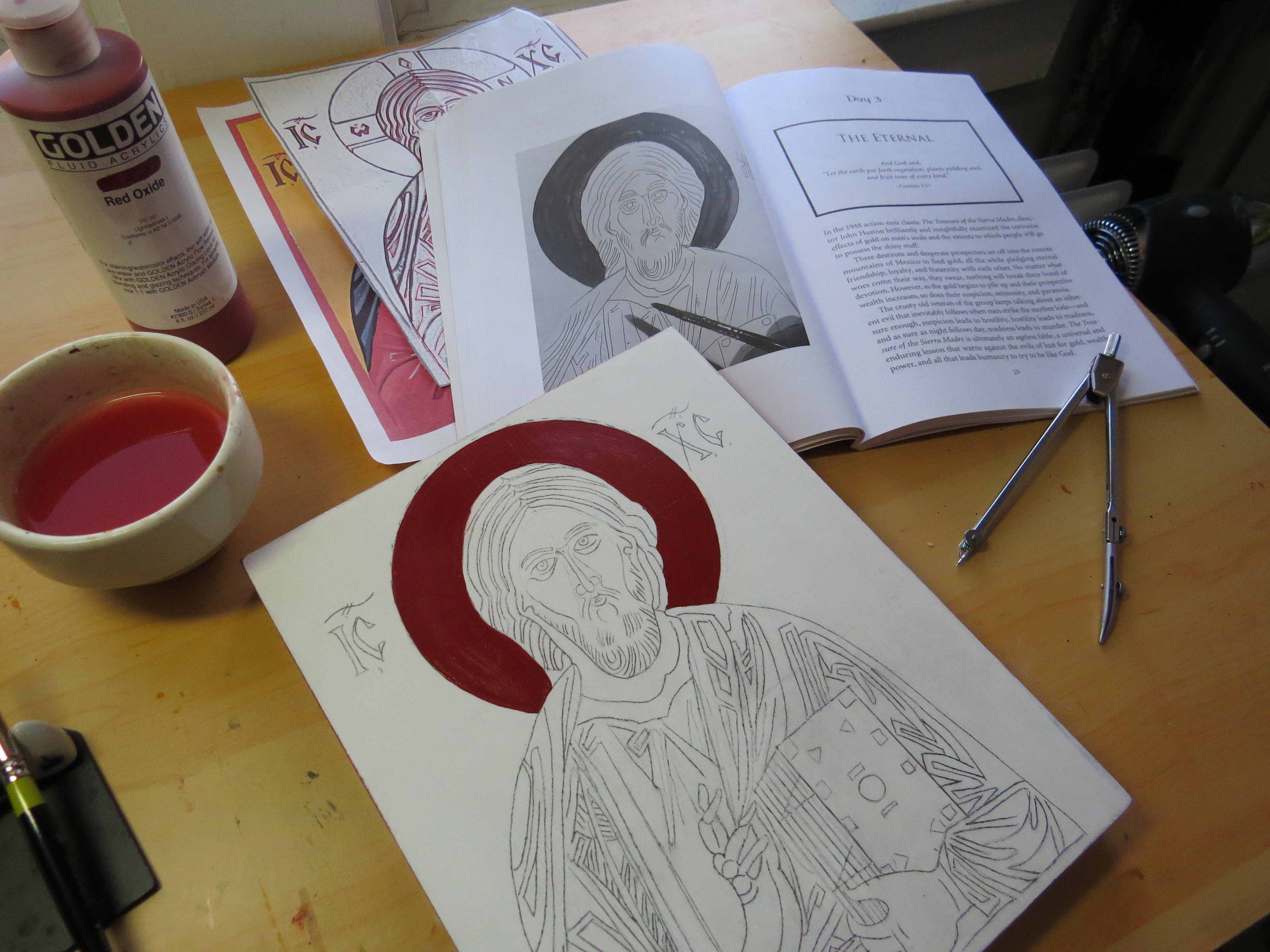Benedictine Oblate Margaret Rose Realy is leading us through an at-home retreat that involves creating an icon. The hard work has begun.
Lenten Campaign 2025
This content is free of charge, as are all our articles.
Support us with a donation that is tax-deductible and enable us to continue to reach millions of readers.
I’ve been working through Joseph Malham’s book Drawing Closer to Christ: A Self-guided Icon Retreat. Now at the half-way point, I am sharing reflections of my journey as I draw closer to Jesus through the process of creating an icon of Christ Pantocrator.
This seven-day retreat is taking much longer—I’m already 14 days in and only halfway through. It hadn’t occurred to me when I committed to the retreat that an arthritic back and hands would be such a hindrance.
That too was part of the spiritual lesson. I am not young, and need to bring all things to Our Lord before beginning, to understand how much I must depend on him to help complete an endeavor.
A step not included in the book—it is assumed we are able to purchase pretreated boards—is applying gesso to the wood panel. Gesso, a combination of paint pigment, chalk, and binder, is used to prepare a surface to receive paint. For an icon, 12 layers are required.
Looking at the untreated wooden panel, I realized it was the gentlest means of entering into the Holy. Like gathering manna in the desert, a repetitive and mundane task, we are given a hunger that reminds us of our dependence on God for what lies ahead.

After the first day of applying the first two of 12 coats of gesso (each layer must dry and be sanded to an even layer between applications) I was impatient to begin the retreat—and realized, I had.
With each sanding, I thought of my own rough soul being smoothed. In each effort to draw closer to the Holy, my faith becomes more level and more ready to receive the Lord.
After six days it was finally time to transfer and etch the image into the gesso board … and on the seventh day he rested.
Etching the outline was physically demanding. My arthritic hand would cramp after just a few minutes, and my tense, hunched back ached with the effort. The gesso didn’t imprint from the stylus as indicated in the book; I had to force the metal tip of the tool into the hard white surface, and feared gouging too deep.

It was necessary for the lines to be clear. They would be the guiding foundation of the icon. No matter what would be placed upon it in the next few days those lines had to be visible. It took me five days to complete the etching—often doubting if I had the stamina—with plenty of time to reflect on faith.
Read more:
The Holy Spirit as Divine Artist
The grooves were relatively deep, so there would be no mistakes determining boundaries. The theme I continued to return to was how my faith, when tested, would fall back to the basics of catechesis. Those were the lines, the deep grooves etched into my thoughts, of how to manage in challenging situations, when things get messy.
Malham’s instructions for applying gold leaf are clear and easy to understand. But this step is not for the faint of heart. I hadn’t anticipated the fragile nature of the leaf. My advice? Don’t hesitate! I did, and the situation became a comedy.
The leaf adheres by static—of the waxed sheet to lift the leaf from its pad, of the board where adhesive isn’t, of fingers, brushes, and work surface. Move too slowly and the space becomes a threat.
I wasn’t confident in my movement with the first sheet, even though it—mostly—landed on the adhesive. I discovered that attempting to reuse leaf fragments from the work area only made the situation worse—they broke into even more tiny fragments. Using a fresh leaf, I tried again. Eventually all the halo was covered, some areas smooth, though more with crinkles. It wasn’t perfect but perfectly fine.
In my attempts to brush and polish the gold leaf, I found the particles taking on a life of their own, getting on everything worse than grade school glitter! And then I chuckled, as we often do through our nose, and gold particles flew everywhere—to my chest, eyelashes, rug, and even to the home altar four feet away.
Sometimes following Jesus is messy and funny.

There is a list of needed acrylic paints, a few of which I didn’t have. Since only 2 oz., at most, is needed of each color, I mixed together a few paints on hand and was able to acquire similar shades. As I worked with the tiny puddles of color—mixing the dabs, then brushing a stroke on paper to match the suggested shade—Malham’s comment, about our “spiritual DNA” personalizing the icon, struck home.
It’s my DNA, which makes me unique in God’s creation, that also establishes how I approach my Lord. Faith is as personal as the colors I’ve created. Not exactly as instructed, but a work in progress matched to the tools at hand. God comes to each of us as we are, where we are; and we meet him within our distinctness.
As the author states, there is a sacred nature to each step—an intentionality in our journey.
And now I must get back to the journey of creating this icon. I’m at the half-way point, and eager for what lies ahead. You’ll see soon enough the Face of Christ that I’ve painted.

Read more:
Did you know that an Ignatian retreat can change your brain?







